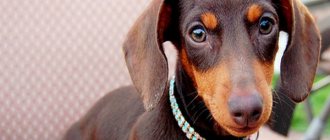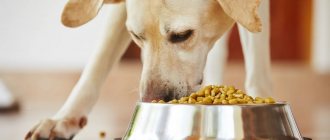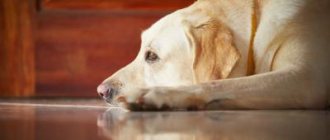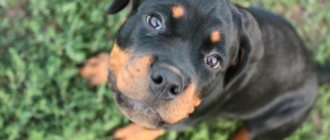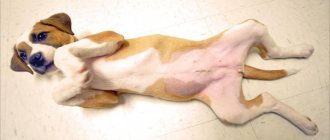In what cases should you change food?
For the first two months of life, the puppy sucks its mother's milk. Next, the breeder gradually transfers him to an “adult” balanced diet. When a dog reaches old age, it becomes necessary to remove solid food from his diet. The following factors also require switching your dog to another food:
- changes in the owner’s life (business trips, new job, appearance of children);
- frequent eating disorders (constipation, diarrhea, bloating);
- dullness, hair loss;
- obesity or underweight;
- refusal to walk, lethargy, drowsiness.
Before changing feeding, it is necessary to show the dog to a veterinarian to exclude the development of diseases.
Manufacturers of animal food regularly replenish their range of products. New brands are appearing that take into account the needs of dog breeds: Labradors, Chihuahuas, Yorkies, terriers, huskies. Seeing them on the shelves, owners strive to switch the dog from one familiar dry food to another dry food.
Why switch your dog to another food?
There may be several reasons for switching an animal to another food.
No one can guarantee that the food the owner uses is balanced by:
- proteins;
- fats;
- carbohydrates;
- minerals;
- vitamins.
Laboratory studies confirm this fact. Even the most expensive food from popular brands does not correspond to what is written on the packaging.
By preferring the same food over a long period, the owner puts the dog at risk. An unbalanced diet can lead to vitamin deficiency or mineral deficiency. Experts do not recommend constantly feeding your dog single ration food . It is better if dry food is changed from time to time, or natural diet is added dry in cases of extreme need.
Feeding during illnesses and pathologies requires special attention. Even if the dog eats the food willingly, the following may occur:
- no formation of fecal matter;
- foul odor of fecal matter;
- frequent alternation of diarrhea and constipation;
- vomit;
- urge to vomit;
- redness of visible mucous and serous membranes;
- dull coat;
- excess weight (this takes into account activity and energy consumption);
- thinness with normal appetite, but energy consumption is also taken into account here.
It should be noted that all of the above symptoms can also occur with invasive, infectious and non-contagious diseases. If the situation becomes more complicated, you should consult a doctor and undergo an examination.
Types of food
The dog can be fed natural products, dry food, and canned food. Each type of food has advantages and disadvantages.
Natural products
These include raw and cooked meat, cereals, dairy products, vegetables, and fruits. The advantages of such feeding are confidence in the freshness of food and the ability to increase the amount of certain nutrients. Disadvantages: the need to calculate the diet and spend time preparing dishes.
Dry food
It consists of granules of different composition, taste and smell. During the granulation process, all useful elements are sealed inside the “pad” and are not destroyed or eroded.
Advantages - wide range, ease of storage and dose measuring.
Disadvantages - the inability to check the information on the label, the need to add thickeners and preservatives to the product.
Canned food
During the production process, pieces of meat are ground and enriched with vitamins, minerals, and cereals. The dish is then heated to a temperature at which the starch turns into jelly. The food is packaged in jars and sterilized.
Advantages – convenience of feeding small breed dogs, old dogs that are unable to chew through solid food. Disadvantages: high price, low load on teeth.
Transferring a puppy from dry food to natural products
A small pet should be switched to a natural type of food if, when using a premium diet or food from the Holistic category, it has an intolerance to this food. If the basis of the daily menu is economy-class granules, then natural nutrition will be much better and more beneficial for a growing body.
The owner must adhere to the same basic rules as when transferring an adult to natural products. When compiling a diet, it is necessary to take into account the need to include in its composition:
- 50% protein food . These are meat by-products, meat, fish, dairy products. At the same time, the amount of by-products should not exceed 15%, and the content of the fermented milk component should not be lower than 15-25%;
- 25% of the puppy’s diet is allocated to vegetables and fruits . It is important to remember that the use of raw potatoes and fresh cabbage is unacceptable. You should also not get carried away with fresh beets. It causes loose stools;
- 22% of veterinary nutritionists recommend consuming cereals . The optimal solution would be to use buckwheat, rice, and oatmeal. In rare cases, it is possible to introduce pearl barley, barley or wheat into the diet. Millet, corn or semolina lead to disruption of the gastrointestinal tract and are not recommended for feeding dogs;
- 3% should be sources of vitamins and minerals. This can be brewer's yeast or meat and bone meal, fish oil or ready-made vitamin and mineral complexes.
This is important: In order not to create excessive stress on the pet’s digestive system, experts recommend pouring fresh broth into the dry granules at the initial stage. This will help teach your baby to eat soft food. You can also switch him to canned food.
If for an adult dog the transfer is carried out within 14 days, then for a baby it is better to slow down the pace somewhat and give him time to adapt. The ideal solution would be the duration of each stage being 5-7 days:
- 25% natural feed: 75% soaked;
- 50% natural feed: 50% soaked;
- 75% nat. Feed: 25% soaked;
- 100% nat. Stern.
If your baby refuses to try natural foods, then you should gradually add fresh minced meat (cottage cheese and other soft ingredients) to the soaked granules into his diet.
Transfer to natural nutrition
Owners rarely refuse to feed their pets with industrial food. After all, they are made taking into account the age, breed, and activity of the dog. The reasons for switching to natural food are allergies to preservatives, a categorical refusal of any granules, and difficulties with chewing.
Before radically changing your diet, consult your veterinarian, draw up a sample menu, and find out the list of healthy and prohibited foods. Remember, meat alone is not enough for a dog to maintain health. She needs cereals, kefir, cottage cheese, vegetables, herbs.
Make the transition gradually, over 10-14 days. After this, you can make 10-15 servings at once and freeze them. To do this, cook porridge, meat, steam vegetables. Mix all ingredients, chop, divide into portions, freeze in the refrigerator. Buy fermented milk products separately to improve the functioning of the digestive system. Crispy carrots, raw bones, and jerky will keep your teeth and mouth healthy.
Signs of good nutrition
To understand that the decision to switch a puppy or adult dog to another food was correct, you need to monitor the pet for some time. The following signs indicate a balanced diet:
- Daily bowel movements, stools of normal color and consistency.
- Normal weight, the stomach does not sag, and the ribs do not protrude under the skin.
- Good health, the dog does not whine, does not howl, does not hide in a corner.
- The coat is thick and shiny, without bald patches or intense shedding.
- Highly active during walks, the dog easily climbs stairs, is inquisitive and friendly.
Even if your pet really likes the new food, control the volume of its portions. Obesity weakens a dog's health and quality of life.
Useful tips
A balanced diet is the key to a long healthy life for your pet. Advice from veterinarians will help you better understand your dog's needs.
Be persistent
Many dogs are smart and observant. They know how to manipulate the feelings of their owners and beg for tidbits. Therefore, after deciding to change food or reduce portion sizes, be persistent. Remember that a dog can go without food for several days without harming its health. Eventually she will start eating from the bowl.
Reviews
Ksenia, Saratov
“When my children grew up and began to cook their own food, we agreed to switch our dog to natural food. At first Styopka refused such food, but then he got used to it and began to enjoy eating porridge with meat and vegetables.”
Yuri, Vologda
“My friend was changing his place of residence and asked to adopt his Shar Pei. I agreed, only on the condition that I switch him to dry food. There were no problems with replacing the power supply. Everything went smoothly and quickly.”
What are the consequences of long-term consumption of homogeneous feed?
Not only the same food has a negative effect on the animal’s body, but also a sharp change from dry to natural. Dogs have no limit, they do not know what to do if something unusual and tasty gets into the feeder. And overeating does no one any good.
When the dog is healthy and the reason is only in the food, the breeder will notice due to an incorrect balance of substances:
- Dull and dry wool , it primarily indicates the quality of nutrition.
- Abnormal stool means the stomach does not absorb new nutrients.
- Constant scratching may be caused by an allergen, the pet is itching, in this case a veterinarian’s consultation is necessary.
- Weight loss or excessive obesity.
- Decreased physical activity , when the puppy becomes lethargic, he lacks some elements.
Changing feed should be rational. Frequent changes in diet can lead to stomach ulcers. The first signs of the disease include:
- Vomiting with ejected dark mass and traces of blood.
- Diarrhea with thin black feces.
- Refusal to play, lethargy, apathy, constant lying in one place.
- Loss of interest in food, increased urine output.
- Increased body temperature, thirst, and the pet is breathing heavily.
The nature of the disease will be determined by the veterinarian after examination . Symptoms should alert the owner to take immediate action. Refusal to eat does not prove that the dog is sick; you need to pay attention to the diet and other factors influencing the state of the body.
The diet must be balanced , if it is changed with excess calcium, this is bad for puppies and young animals, they experience:
- Decreased appetite.
- Growth retardation.
- Bone deformation.
- Skin diseases.
- Hypertrophy of the mucous membrane in the stomach.
When the same calcium is not enough, the pet will become aggressive with crooked paws. It should be noted that a lack of vitamins negatively affects the health of dogs. But no less negative will come to the body in excess:
- Squirrel - when feeding only meat products, cracks appear on the paws, dry crusts, itching, and growth of claws.
- Fats – when consuming fatty foods, a greasy coat will form and digestive problems will begin.
- Carbohydrates - watery eyes, unpleasant odor from the mouth, hair loss.
- Minerals - constipation, thirst, vomiting.
If there are few vitamins in the food, this will manifest itself:
- Crusts near the eyes, in the area of the nose, tail.
- Dry skin and shedding coat.
- Peeling of the skin, itching, inflammation.
All problems can be avoided if you feed your pets correctly and change their menu in a timely manner.

